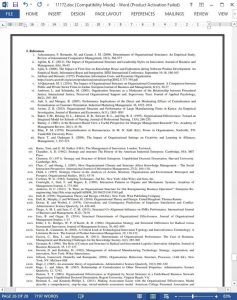Abstract
The relevance of structure to manufacturing firms especially in the pharmaceutical industry in Nigeria has not attracted much attention, especially empirical evidence. Thus, this study examined the effect of organisational structure on the performance of selected manufacturing companies in Enugu State, Nigeria with a focus on pharmaceutical manufacturing firms. The study adopted a Survey design. Three organisations were studied namely: A.C. Drugs Ltd, NEMEL Pharmaceutical Limited and Juhel Pharmaceutical Company Ltd with a population of four hundred and sixty-eight (468). The sample size was determined using Cochram (1963) formula which gave a sample size of 297. The study relied on both primary and secondary data. Materials and information were sourced from the Human Resource Departments of the firms and journal articles including textbooks and students project reports. The questionnaire was the instrument for primary data collection. The methods used in analysing the data are descriptive statistics (frequencies, mean, standard deviation, variance, etc.), simple linear regression and correlation (bivariate) to examine the effect of organisational structure (Independent Variable) on organisational performance (dependent variables). The study found that structure significantly affects organisational performance. The study concludes that organisational structure in pharmaceutical manufacturing firms affects performance except in its growth objective. The study, therefore, recommends that pharmaceutical firms should see their structure as a major determinant of performance and as such, non-performing firms should redesign their structure for optimal performance.
1. Introduction
Organisational structure across the world has attracted widespread attention in terms of research and debate among organisational managers and academia. Managers who set out to design an organisation structure face difficult decisions. They must choose among a myriad of alternative frameworks of jobs and departments. The first decision focuses on individual jobs, the next two decisions focus on departments or groups of jobs, and the fourth decision considers the issue of delegation of authority throughout the structure (Gibson, Ivancevich, Donnelly and Konopaske, 2003). Organisational structure is used by various firms as a control mechanism to affect employee work outcomes, to ensure that the required tasks are performed effectively and efficiently, and to assist the attainment of organisational goals and objectives (Katsikea, Theodosiou, Perdikis and Kehagias, 2011; Al-Qatawneh, 2014). Organisational structure describes the internal characteristics of an organisation (Daft, 1995; Al-Qatawneh, 2014). These internal characteristics receive attention since they are critical to organisational failure and success (Zheng, Yang and McLean, 2010; Auh and Menguc, 2007; Al-Qatawneh, 2014), and one of these is organisational performance. What are the effects of organisational structure on organisational performance is among the fundamental questions of the strategy field and organisation theory (Rumelt, Schendel and Teece, 1994; Thompson, 1967). Organisational structure defines the scope of behaviour within an organisation, its lines of authority, accountability and to some extent, the organisation’s relationship with its external environment. It shows the pattern of relationship with jobs within an organisation (Tracey, Cullen and Slocum, 2009; Thompson and Lawrence, 2010). Organisational structure determines the pattern of communication as well as the formal lines of interaction between individuals within organisations (Robbins, 1990; Teixeira, Koufteros and Peng, 2012).
4.2. Conclusion
The study tried to examine the effect of organisational structure on the organisational performance of selected manufacturing companies in Enugu State, Nigeria. Arising from the results, the study concludes that organisational structure in manufacturing companies affects organisational performance except in its growth objective. By implication, manufacturing firms must be wary of their structure as it could affect their performance which is critical to the achievement of their goals.











